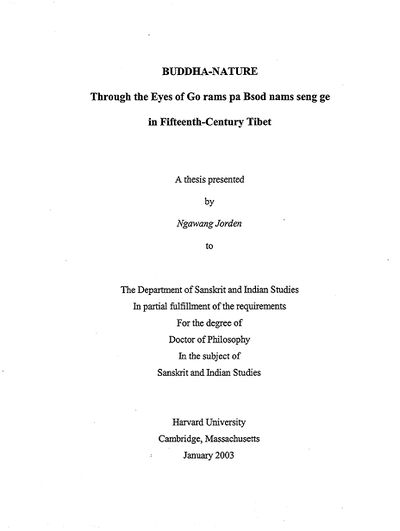Buddha-Nature: Through the Eyes of Go rams pa Bsod nams seng ge in Fifteenth-Century Tibet
< Books
| (6 intermediate revisions by the same user not shown) | |||
| Line 3: | Line 3: | ||
|PersonPage=Jorden, N. | |PersonPage=Jorden, N. | ||
|PersonName=Khenpo Ngawang Jorden | |PersonName=Khenpo Ngawang Jorden | ||
| + | }}{{Book-person | ||
| + | |PersonPage=Go rams pa bsod nams seng ge | ||
| + | |PersonName=Gorampa Sönam Senge | ||
}} | }} | ||
|FullTextRead=No | |FullTextRead=No | ||
| Line 12: | Line 15: | ||
***{{i|Research Strategy and Methodology|8}} | ***{{i|Research Strategy and Methodology|8}} | ||
***{{i|Introduction to the ''Sdom Gsum Kha Skong''|10}} | ***{{i|Introduction to the ''Sdom Gsum Kha Skong''|10}} | ||
| − | ***{{i|The Topical Outline of the First Chapter of the ''Sdom Gsum Kha Skong''|13}} | + | ****{{i|The Topical Outline of the First Chapter of the ''Sdom Gsum Kha<br>Skong''|13}} |
*{{i|CHAPTER I - BRIEF HISTORY OF THE SA SKYA SCHOOL|20}} | *{{i|CHAPTER I - BRIEF HISTORY OF THE SA SKYA SCHOOL|20}} | ||
**{{i|'Khon Family Lineage|20}} | **{{i|'Khon Family Lineage|20}} | ||
| Line 48: | Line 51: | ||
***{{i|Mang thos's Understanding of Go rams pa's Intention|84}} | ***{{i|Mang thos's Understanding of Go rams pa's Intention|84}} | ||
***{{i|The Two Purities are Mutually Exclusive|85}} | ***{{i|The Two Purities are Mutually Exclusive|85}} | ||
| − | *{{i|CHAPTER IV - GO RAMS PA'S REFUTATION OF JO NANG PA ON BUDDHA-NATURE|89}} | + | *{{i|CHAPTER IV - GO RAMS PA'S REFUTATION OF JO NANG PA ON<br>BUDDHA-NATURE|89}} |
*{{i|PART II|89}} | *{{i|PART II|89}} | ||
**{{i|Refutation of Truly Existing Buddha-nature|89}} | **{{i|Refutation of Truly Existing Buddha-nature|89}} | ||
| Line 70: | Line 73: | ||
**{{i|Ascertainment with evidence|128}} | **{{i|Ascertainment with evidence|128}} | ||
*{{i|APPENDICES|130}} | *{{i|APPENDICES|130}} | ||
| − | **{{i|Appendix A: The text of ''sdom gsum kha skong'''s first chapter on basis (''gzhi'') and its translation|130}} | + | **{{i|Appendix A: The text of ''sdom gsum kha skong'''s first chapter on basis (''gzhi'')<br>and its translation|130}} |
**{{i|Note on the Versification|130}} | **{{i|Note on the Versification|130}} | ||
**{{i|The Text and Translation|130}} | **{{i|The Text and Translation|130}} | ||
**{{i|Appendix B: Go rams pa's writings|181}} | **{{i|Appendix B: Go rams pa's writings|181}} | ||
| − | **{{i|Volume |182}} | + | **{{i|Volume I|182}} |
**{{i|Volume II|187}} | **{{i|Volume II|187}} | ||
**{{i|Volume III|188}} | **{{i|Volume III|188}} | ||
| Line 98: | Line 101: | ||
**{{i|Primary Sources of Works by Tibetans|212}} | **{{i|Primary Sources of Works by Tibetans|212}} | ||
**{{i|Secondary Sources|215}} | **{{i|Secondary Sources|215}} | ||
| + | |StopPersonRedirects=No | ||
|AddRelatedTab=No | |AddRelatedTab=No | ||
}} | }} | ||
Latest revision as of 22:13, 1 June 2023
Abstract
This dissertation explores the evolving interpretation and understanding of the Buddha-nature in Fifteenth-Century Tibet, through the eyes of Go rams pa Bsod nams seng ge (1429-1489), a prominent scholar of the Sa skya school of Tibetan Buddhism. The previous work of European and American scholars in this field have led to our general understanding of Buddha-nature as an innate potential for enlightenment that lies within all sentient beings. The concept of Buddha-nature provides the primary answer to a question with which all Mahāyānists have been philosophically concerned, throughout history: are all sentient beings capable of attaining Buddhahood? The Mahāyāna, more specifically, Madhyamaka theory of Buddha-nature answers the question unequivocally: "Since all sentient beings possess Buddha-nature they are guaranteed to achieve the state of Buddhahood." This research has been mostly limited to the interpretations of Indian and Chinese texts and to a study of only certain Tibetan schools. This dissertation seeks to fill the gap in present scholarship by analyzing the systematic thought of Go rams pa, who set out to provide a critical analysis, explain the internal coherence, and map out the organization of diverse Indian and Tibetan interpretations of this complex idea. I demonstrate in two fundamental ways that Go rams pa developed an unique view of Buddha-nature in two ways: First, I explore the facts Go rams pa's interpretation of Buddha-nature that contribute to his unique perspective. Second, I analyze his opponents' views on the subject thereby illuminating its distinctive features in an historical context. Throughout this study, I deploy a comparative apparatus considering the different views that Go rams pa thought was wrong. Given this fifteenth-century debate, we realize that the understanding of Buddha-nature is subtle and complicated; yet this study is vital to explicate its implications. I conclude that according to Go rams pa, Buddha-nature is to be understood as unity of the emptiness of the mind and clarity which is the nature of mind.
| Citation | Jorden, Khenpo Ngawang. "Buddha-Nature: Through the Eyes of Go rams pa Bsod nams seng ge in Fifteenth-Century Tibet." PhD diss., Harvard University, 2003. |
|---|---|

